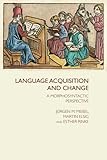Language Acquisition and Change : A Morphosyntactic Perspective / Esther Rinke, Jurgen Meisel, Martin Elsig.
Material type: TextPublisher: Edinburgh : Edinburgh University Press, [2022]Copyright date: ©2013Description: 1 online resource (208 p.) : 9 B/W tables 6 B/W line artContent type:
TextPublisher: Edinburgh : Edinburgh University Press, [2022]Copyright date: ©2013Description: 1 online resource (208 p.) : 9 B/W tables 6 B/W line artContent type: - 9780748642250
- 9780748677993
- 417.7 23
- P142 .M45 2013
- online - DeGruyter
- Issued also in print.
| Item type | Current library | Call number | URL | Status | Notes | Barcode | |
|---|---|---|---|---|---|---|---|
 eBook
eBook
|
Biblioteca "Angelicum" Pont. Univ. S.Tommaso d'Aquino Nuvola online | online - DeGruyter (Browse shelf(Opens below)) | Online access | Not for loan (Accesso limitato) | Accesso per gli utenti autorizzati / Access for authorized users | (dgr)9780748677993 |
Frontmatter -- Contents -- Preface -- Abbreviations -- 1. Variation and change in languages -- 2. Language change across the lifespan -- 3. The child as the locus and agent of grammatical change -- 4. Structural ambiguity as a possible trigger of syntactic change -- 5. Language contact as a possible trigger of change -- 6. Acquisition in multilingual settings: Implications for explanations of change -- 7. Towards an explanatory theory of grammatical change -- References -- Index
restricted access online access with authorization star
http://purl.org/coar/access_right/c_16ec
Historical linguistics commonly invokes the child as the principal agent of change. Using this as a starting point, the authors address diachronic language change against a background of insights gained from extensive research into mono- and bilingual language acquisition. The evidence shows that children are remarkably successful in reconstructing the grammars of their ambient languages so the authors reconsider a number of commonly held explanatory models of language change, including language contact and structural ambiguity in the input. Based on a variety of case studies, this innovative take on the subject argues that morphosyntactic change in core areas of grammar typically happens in settings involving second language acquisition. Here, the children acting as causal agents of restructuring are either second language learners or are continuously exposed to the speech of second language speakers. The authors answer questions about the circumstances surrounding grammatical change in terms of a restructuring of speakers' internal grammatical knowledge constructing a general theory of diachronic change consistent with insights from language acquisition.
Issued also in print.
Mode of access: Internet via World Wide Web.
In English.
Description based on online resource; title from PDF title page (publisher's Web site, viewed 02. Mrz 2022)


